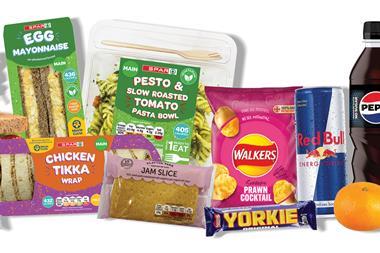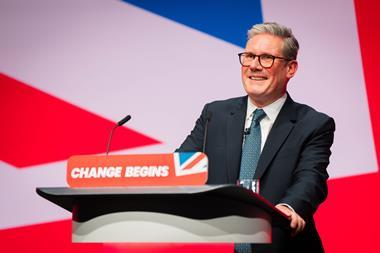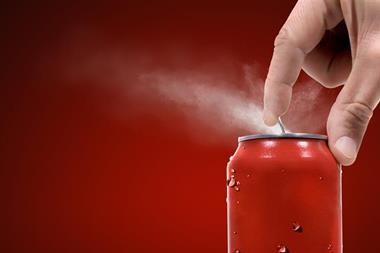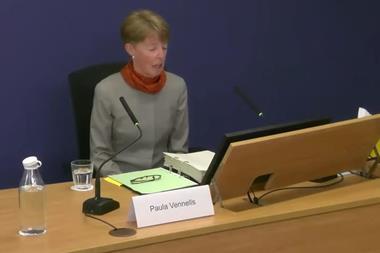If you asked 10 customers to sum up your store in a couple of words how many of them would reply ‘good value’? While ‘convenience’ and ‘friendliness’ are important, a store has no hope of reaching its full potential if the customer’s perception of its value is a bad one. So how do you cultivate the idea that you offer good value, and does this always have to rely on price?
For Mark Callaway, the secret of driving value in his Salisbury Bargain Booze Select Convenience is making sure promotions cover multiple aspects. “It’s no good just deep discounting - you have to have a multi-faceted promotion over several lines and combine it with pricemarking,” he says. “For something like cereal, pricemarked packs work really well. It’s an expensive item and they’re big boxes with a big pricemark across the top so it’s a good visual impact, and it’s a good cash earner. Plus they’re a multiple category - there are not many homes that have just one box of cereal as everyone in the family has their favourite so there could be three or four on the go all at the same time. Customers also buy milk with it.”
However, he says that he sees no need to discount milk as the volume of sales wouldn’t increase enough to warrant it.
Mark adds that he’s seen a big change in promotions over the past five to 10 years with supermarkets entering the convenience sector: “They’ve raised the bar as to what the customer expects and what we are expected to deliver and this is as true in pricing as elsewhere.”
How to add value
● Choose your categories carefully. Products such as rolling tobacco and cigarettes are very price-sensitive but high value, which is why pricemarks work well. Alcohol lends itself well to multi-deals and customers will often buy two or three cases at a time on a really good deal
● Pound zones need big brands. As David Heritage points out: “There’s no point having a poundzone if you’re selling biscuits from Outer Mongolia - customers won’t go for them.”
● Choose your location. Gondola ends facing the door and floor displays are perfect places to catch the attention of customers, but don’t be surprised at what it is possible to miss. This is why multi-siting is important for deals. Make sure you have the item on deal in its usual place as well as in the deal zone, otherwise rushed customers may think the item is out of stock.
● Do the maths. Balancing increased footfall and sales against lost margins can be a tricky for retailers, but at the end of the day you need to know exactly what works and what doesn’t. Multiples can afford to take big losses which they’ll just pass back to the suppliers - few c-stores can.
Half the skill is to manage the expectation of the customers, he says, as well as keeping promotions relevant to your customer base. “It’s no good quadrupling sales in some areas if it only means you sell an extra four units of that product. For instance, we don’t do many children’s products because we don’t get children or mothers in. We could run the best promotion in the world but it wouldn’t guarantee any extra footfall. You have to tailor your promotional programme to your customer type. At the moment, we’ve got Doritos in a £1 pricemarked bag for 100g. It’s a good margin for us and a good brand. I’d love it if every promotion could be like that one.”
However, Mark says that the pressure to discount can sometimes be extreme: “I’ve been in meetings where we’ve been encouraged to discount pricemarked items, but I think if a convenience store customer sees a pricemarked pack and thinks it’s a good deal there is no need to go lower. And you’ve got to watch the margins. The traditional viewpoint has been that the retailer should always make more on margins than the wholesaler. With the current Doritos promotion a £1 bag has a margin of 25p, whereas a Crinkles multipack will only get you about 9.6p once you take off the VAT. I cannot work on margins like that.”
Keeping the customers on their toes is another key to driving sales, according to Pinda Cheema of Malcolm’s Stores, Coventry. The store uses signage and its own labels to reinforce price discounts, but also keeps offers fresh by moving things around the store. “You have to keep it fresh and keep changing the location of displays,” he says. “We change the displays once a week. With something like Yorkshire Tea, we’ll have it on offer, but we shift the offer around and it will sell well to different customers in different locations. If you don’t change things around you miss sales.”
The store has 25 stacks dotted around with some permanent promotional displays and some set up between aisle breaks.
The family-run store often uses Costcutter deals, but also sources deep discounts itself, offering prices comparable to discount retailers such as Poundland to really drive customers in. “With the deep discounts we’ve currently got Coke Zero on offer at £5 for 24 bottles and Corona £3 for a pack of four,” says Pinder. “If you’re going to take a few pallets into the shop you need to know you’ll be shifting three or four cases a day at the very least. For instance, we’ve got Comfort 5ltr priced at £4.59, which works out cheaper than Poundland, and we sell about six cases a day.”
Pinder says that the great thing about deep discounts is that they avoid the lull period during the summer holidays. “It stops stagnation. And there are certain things that always sell well: softener, detergent, chocolate, teabags - even if customers have these at home they’ll buy extra if the price is right.”
While pricing may be one of the ways of increasing value perception, using local marketing to drive customers into the store is another. For Andrew Porter of Eurospar Creightons of Finaghy, Belfast, utilising the ‘leaflet brigade’ has proven a sales winner. Every three weeks the store sends out 25,000 leaflets to the surrounding area. “We’ve done leaflets for about 10-15 years, first with Nisa then, since 2005, with Spar,” he says.
“We know people get the leaflets through their door and sit down and mark the offers and come in on the first Monday of the new three-week marketing cycle and go round with a trolley and head for the offers.” He adds that any initial fears that the leaflets would leave him out of pocket evaporated years ago. “It’s worked really well, and it’s the promotional offers on the leaflets that are really driving buying. Customers are buying everyday items as well. We’re far beyond wondering whether the leaflets pay for themselves as sales have grown over the year based on the number of leaflets we distribute.”
He says that the types of discount that sell really well are the round pound lines, but that he’s noticed a change in the categories this applies to. “It used to be toiletries and household products that sold best, but they’re not going as well at the moment. As for pound bags of sweets or large blocks of chocolate - we just can’t keep them on the shelves. Take Bassetts Liquorice Allsorts which might have sold for £1.60 - we sell a slightly smaller bag for £1 and sell 10 for every one of the standard bags. We’re nearly at the point of cutting out the standard bag it’s going so well.”
However, it’s important to realise that while discount pricing is very effective for some lines, in others it can actually see a sales drop. Sometimes the perception of the customer is that expensive equals better - and it doesn’t only apply to the beauty industry. Retailers selling everything from gifts through to sun creams have found that those particular categories can actually increase in value to the customer if they have a more expensive price point.
Retailer David Smith of Smith’s Corner, Grimoldy, Lincolnshire, says that while he carries discounts on beer and wine, when it comes to his wine of the month offering, some customers regard discounting as a personal affront. “If we get the price too low it puts people off,” he says. “People who buy that sort of thing like to regard themselves as knowledgeable about wine so a price point of between £7-£14 appeals to them. They feel like they’ve made an intelligent decision about the wine and the price backs this up. By putting down the price you’re saying that your customer’s decision-making doesn’t have value and this product doesn’t have the value that they think it does.”
David also makes sure staff are knowledgeable about the wine of the month so that they can engage customers in conversation and reinforce their decision-making.
Pricing may be the most obvious way of tackling customer value perception, but there’s a lot to be said for clever marketing to encourage loyalty. While many smaller retailers might question the relevance of a loyalty card scheme to their store, David and Pippa Heritage of Barns Green Village Store in Horsham, West Sussex, have managed to make it work for their 1,000sq ft shop. Says David: “As we are a village store out in the sticks with a campsite next to us, we don’t need pricemarking. Apart from cereal - we sell loads because the campers always forget it.”
Looking around for something to entice customers, though, David started to research the feasibility of loyalty cards. After doing a bit of research into the subject, he met a supplier to talk details. But while he was impressed by the viability of the project, he found it hard to justify the initial outlay of £1,500. The only thing for it, he thought, was to do something himself. “So I went down to the local printers and got some cards printed up,” he explains. “The cards have 25 empty circles on it and each time customers spend £5 they get a smiley face stamp.” The only items excluded from the deal are tobacco, Lottery and PayPoint, because they are high value but low margin items - it wouldn’t have been worth it. Once the customers have got 25 smiley faces they get £5 off their next shop.
“Customers love it and see it as good value for money,” David says. “Many people come in prepared to spend about £3.50 before realising they won’t get a smiley face, so spend a bit more to bring the spend up to £5. It’s really pushing those extra sales,” he explains. “All the customers have the card, which equates to a £125 spend, so it’s a really worthwhile exercise.” ■




























No comments yet